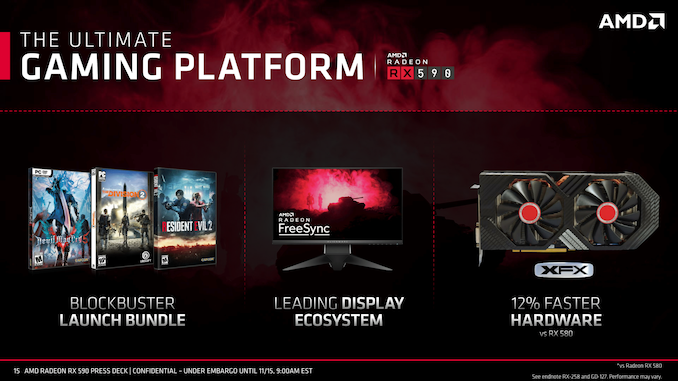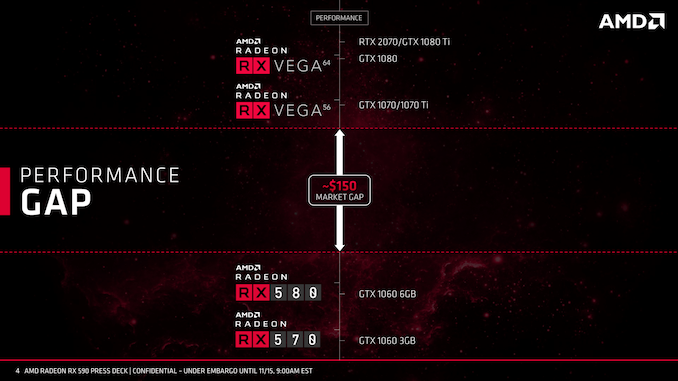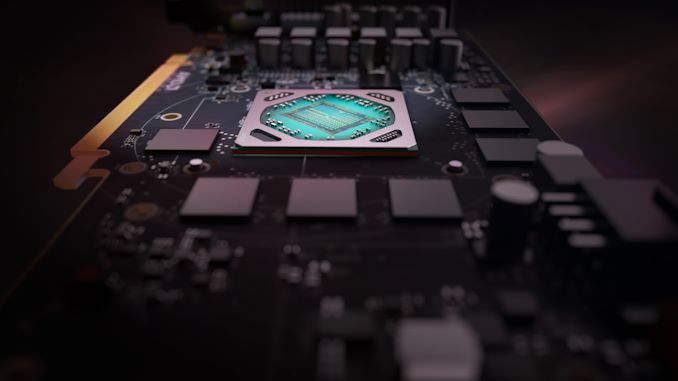The AMD Radeon RX 590 Review, feat. XFX & PowerColor: Polaris Returns (Again)
by Nate Oh on November 15, 2018 9:00 AM ESTClosing Thoughts
As we bring this to a close, the Radeon RX 590 features few, if any, surprises, indeed outperforming the RX 580 via higher clockspeeds but at the cost of additional power consumption. This is enabled by being fabbed on 12nm and being afforded higher TBPs, but in terms of overall effect, the port to 12nm is less of a die shrink and more of a new stepping; in terms of transistor count and die size Polaris 30 is identical to Polaris 10. Feature-wise, whereas the RX 500 series did introduce a new mid-power memory state, the RX 590 doesn't add anything.
Altogether, AMD is helping push the RX 590 along with a three-game launch bundle and emphasizing the value of FreeSync monitors. One might add that the RX 590 also makes the most out of the game bundle, which now presents itself as a direct value-add for the card. But the card by itself isn't providing more bang for your buck than with the RX 580.
By the numbers, then, where does the RX 590 land? Reference-to-reference, the RX 590 is about 12% faster than the RX 580 at 1080p/1440p, and 14-15% faster than the RX 480. Across the aisle, this turns out to be 9% faster than the reference GTX 1060 6GB, though the GeForce card still takes the lead in games like GTA V and Total War: Warhammer II. That matchup itself is more-or-less an indicator of how far Polaris has come - the RX 480 at launch was 11% behind the GTX 1060 6GB, and the RX 580 at launch was 7% behind. Improvements have come over the years with drivers and such, where the RX 480 and RX 580 are much closer, but the third time around, Polaris can finally claim the victory at launch.
That being said, the 9% margin is well within reach of factory-overclocked GTX 1060 6GB cards, especially with a 9Gbps option that the RX 590 doesn't have. Even with the XFX Radeon RX 590 Fatboy the delta only increases to about 11%. In other words, as custom factory-overclocked cards the RX 590 and GTX 1060 6GB are likely to trade blows. And heavily factory-overclocked RX 580s are in the similar situation.
But similar to the RX 580 and 570, the RX 590 achieves this at the cost of even more power consumption. In practical situations like in Battlefield 1, the RX 590 results in the system pulling around 110W more from the wall than with the GTX 1060 6GB. The RX 590 is not a power efficient card at the intended clocks and TBP, and so won't be suitable for SFF builds or reducing air conditioning usage.
Once again though, we've observed that VRAM is never enough. It was only a few years ago that 8GB of VRAM was considered excessive, only useful for 4K. But especially with the popularity of HD texture packs, even 6GB of framebuffer could prove limiting at 1080p with graphically demanding games. In that respect, the RX 590's 8GB keeps it covered but also brings additional horsepower over the 8GB R9 390. For memoryhogging games like Shadow of War, Wolfenstein II, or now Far Cry 5 (with HD textures), the 8GBs go a long way. Even at 1080p, GTX 980/970 performance in Wolfenstein II tanks because of the lack of framebuffer. For those looking to upgrade from 2GB or 4GB cards, both the RX 580 and RX 590 should be of interest.
So in terms of a performance gap, the custom RX 590s seem poised to fill in, though it might be in the range of 5 to 10% when comparing to existing heavily factory-overclocked RX 580s. That gap, of course, would likely have been filled by a 'Vega 11' product, which never came to fruition. Beyond a smaller discrete Vega GPU, 12nm Vega seems less likely given that 14nm+ Vega is no longer on the roadmap. And with 7nm Vega announced as Radeon Instinct MI60 and MI50 accelerators, there's no current indication of those GPUs coming into the consumer space. We also know very little about Navi other than being fabbed with TSMC on 7nm and due in 2019.
So of the possible cards in AMD’s deck, we are seeing a single 12nm Polaris SKU slotting in above the existing RX 580. If there are no further refreshes coming, then gamers will naturally ask when Polaris will be replaced as AMD's mainstream offering, as otherwise the RX 500 series will be holding the fort until then. If this is a prelude to further refreshes, then it becomes a question of how much more performance can be squeezed from Polaris.
The bigger picture is that from the consumer point-of-view, RX Vega in August 2017 was the most recent video card launch before today. There are more pressing concerns in the present: NVIDIA's recently-launched Turing-based GeForce RTX 20 series, as well as Intel's renewed ambition for discrete graphics and subsequent graphics talent leaving AMD for Intel. While the RX 590 avoids the optics of having no hardware response whatsoever in the wake of the RTX 20 cards, it is still a critical juncture with respect to DirextX Raytracing (DXR) development. And regardless, Intel has announced 2020 as the date for their modern discrete GPUs.
So as we head into 2019, it will be a crucial year for AMD and RTG. But returning to the Radeon RX 590, it applies pressure to the GTX 1060 6GB and older GTX 900 series cards, while avoiding direct pressure on existing RX 580 inventory by virtue of pricing. And right now, without anything to compete with the GTX 1080 Ti/RTX 2070 range or above, AMD is likely more than happy to take any advantage where they can. For now, though, much depends on the pricing of top-end RX 580s.













136 Comments
View All Comments
deksman2 - Friday, November 16, 2018 - link
It would be an unfair comparison because AMD is using GLOFO 12nm LP node designed for low clocks and mobile parts, whereas NV is using TSMC 16nm high performance process designed for high clocks and efficiency.You can't compare the two back to back and NV would still win in such a situation.
But, for the sake of argument, a Polish website (at least I think it was Polish) apparently managed to undervolt RX 590 just recently and total power consumption dropped by 34W.
Here's the website:
https://pclab.pl/art79190-20.html
Polaris power consumption problems stem from a combination of problems:
1. (and this would be the biggest) GLOFO 14nm/12nm process nodes designed for low clocks and mobile parts (not worth it even raising frequencies on 12nm because as we saw, both Ryzen+ and Polaris were already boosting WAY past the GLOFO node 'comfort zone' to the point efficiency was thrown out the window.
2. lower yields on GLOFO nodes contributed towards lack of voltage optimisation resulting in higher maximum voltages on GPU's shipping from factory.
3. Excessive amount of compute hardware. Polaris has powerful compute which is not really used in games, and this hardware does suck up a lot of power, and Polaris in general has about 40% more stream processors than Pascal has CUDA cores.
Kurosaki - Friday, November 16, 2018 - link
I still don't see any incitement to upgrade from my 290X, sad in a way.. : /eva02langley - Friday, November 16, 2018 - link
Vega 56 if they are on sale for the right price...However yeah, no reason to change.
The_Assimilator - Friday, November 16, 2018 - link
*sound of dead horse being beaten*Santoval - Friday, November 16, 2018 - link
How long will AMD keep squeezing the blood out of Polaris? They have practically abandoned their GPU division, their mainstream one anyway. A single refresh could be occasionally justified, but a refresh-squared of the same GPU (or GPU series) equates with rebranding.I realize that they overwhelmingly focused on their CPU and APU division in order to compete with Intel, and that drew resources and engineers from the GPU division. But competition is required in the GPU market as well, or else Nvidia will keep charging an arm and a leg for their graphics cards.
samal90 - Friday, November 16, 2018 - link
you didn't mention in the Wolfenstein 2 page, that the RX590 performs like a GTX 1070. It's an interesting observation that should be investigated.deksman2 - Friday, November 16, 2018 - link
Probably because the game is well optimised for AMD hardware (a situation which is all too uncommon).But AMD's main problems stem from using an inefficient GLOFO nodes.
14nm and 12nm were both designed for low clocks and mobile parts... this is why we see massive increase in power consumption for Polaris at high frequencies... because the GPU is clocked WAY past the voltage comfort zone where it would be efficient.
TSMC nodes are designed for high clocks and efficiency... and as such, they WILL have an advantage in clocks and power consumption.
DominionSeraph - Friday, November 16, 2018 - link
Does this win the award for most pointless launch of all time? Anyone who was in the market for a GTX 970/1060 class GPU in the GTX 970/1060 price range probably bought a GTX 970 or GTX 1060 already. Releasing a more power hungry card over 4 years late doesn't really seem like it's going to move the market.When Nvidia was 6 months late with the housefire GTX 480 they at least had the performance crown compared to the 5870. This is 4 years late and has nothing.
spdfreak - Saturday, November 17, 2018 - link
Seems like a used RX 480 8GB is probably the best value out there for 1080 gaming. Plenty of them for about 100.00 on ebay. I keep looking for the price of 1060 6GB cards to come down now that there is a glut of them, but they stay stubbornly high.neblogai - Sunday, November 18, 2018 - link
RX570s are about as fast as RX480, but start at ~$150. They are new, come with warranty, and with 2 AAA games which can be considered to be worth ~$120 if you want them, or ~$60 for reselling. RX570 is a better deal.